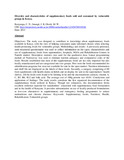| dc.description.abstract | Objectives: The study was designed to contribute to knowledge about supplementary foods available in Kenya, with the view of helping consumers make informed choices when selecting health-promoting foods for vulnerable groups.Methodology and results: A previously pretested, semi-structured questionnaire was used to collect information on the types, characteristics and use of supplementary foods from supermarkets, hospitals,
NGOs and Rehabilitation Centers in Nairobi market. Descriptive statistics was used for the qualitative data. Linear programming module of Nutrisurvey was used to estimate nutrient adequacy and comparative costs of the foods. Results established that most of the supplementary foods are not only imported but also locally manufactured and are categorized into two groups. First were the foods recommended for rehabilitation programs but were not available for sale in the open market. Nutrition information and shelflife are displayed on the labels of these foods. Secondly, a category comprising of 80 food supplements with health claims on labels and on display for sale in the supermarkets’ health shelves. All the foods were found to be limiting in fat and the micronutrients calcium, vitamin A, C, B5, B6, B12 and folic acid. The average cost of 100g protein was €0.01. Conclusions and application of findings: The study results constitute the first organized documentation of the supplementary foods utilized in Kenya. Though not exhaustive, the documentation forms excellent reference material for stakeholders’ concerned with supplementary food formulation and in the health of
Kenyans. It provides substantiation on use of locally-produced formulations as low-cost alternatives in supplementary and emergency feeding programmes to reduce malnutrition and chronic diseases. Keywords: Supplementary foods; Nutrition; Health; Rehabilitation; Vulnerable groups. | en |

